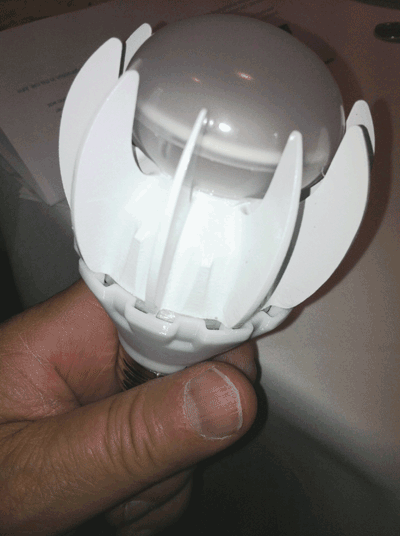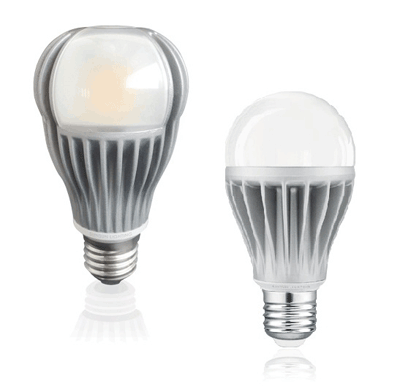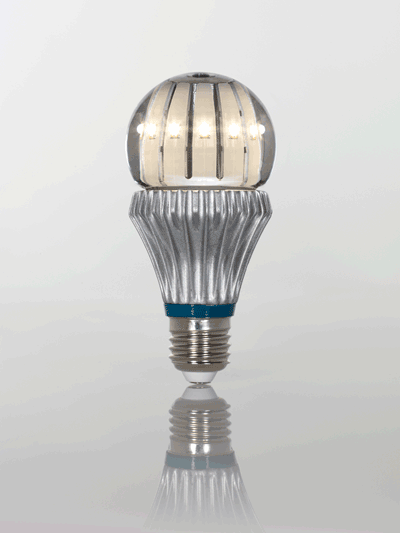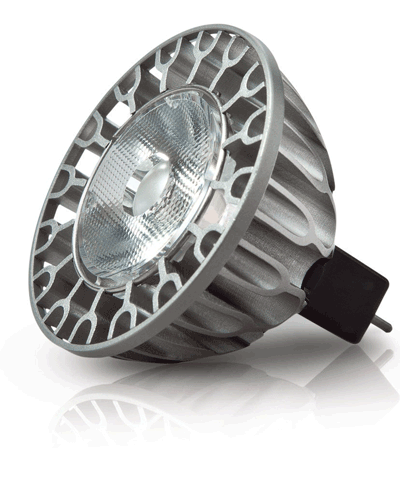
To paraphrase the old joke, “I just flew in from Lightfair and, boy, are my eyes tired.” There were so many new, bright LED-based bulbs and lamps at Lightfair 2012 that some suggested that the name of the show should be changed to “LEDfair.”
One of the first things to catch the crowd’s attention was GE Lighting’s (www.gelighting.com) announcement that it would deliver a 100-W-incandescent-equivalent LED bulb next year. The bulb would consume only 27 W and be priced at about $35. What was really special about the prototype displayed at the show is that it’s the first LED replacement bulb to use active cooling. GE Lighting collaborated with Nuventix (www.nuventix.com) to adapt the latter’s SynJet technology to fit into the base of an A-19 bulb. SynJet uses a quiet oscillating diaphragm to shoot out bursts of air; the new design moves the air over the external fins surrounding the head of the bulb to keep the LEDs operating at the right temperature (Fig. 1 ).

Fig. 1: GE Lighting’s prototype LED bulb aims to replace 100-W incandescents using active cooling. Vents at the bottom of the fins direct pulsed air from a Nuventix-technology device in the bulb’s base over the fins.
Making its Lightfair debut was SunSun Lighting (www.susunlighting.com), a Nanjing, China, company with backing from Oak Investment Partners (www.oakvc.com) and GSR Ventures (www.gsrventures.com). In addition to the tri-lobed silicon-based 12-W LED bulb, said to be an industry first, SunSun was showing a 60-W-replacement LED bulb that uses only 8 W to deliver 800 lm of warm-white light (2,700K) with a CRI greater than 90 and an R9 of 80 (Fig. 2 ). When the 25,000-hr bulb hits U.S. shelves later this year, the price tag will be $15 or less, according to the company.

Fig. 2: In addition to its tri-lobed 12-W silicon-based LED bulb (left) SunSun Lighting plans to deliver an 8-W LED bulb that can replace a 60-W incandescent for around $15 (right).
Switch Lighting (www.switchlightingco.com) returned to the show this year with the announcement that its esthetically pleasing 40-, 60-, and 75-W-replacement LED bulbs are ready to ship, and that its 100-W LED would be ready shortly (Fig. 3 ). The company also demonstrated a prototype of an industry first: a three-way LED bulb. The company believes its patents may prevent others from delivering anything like it.

Fig. 3: Switch Lighting’s 40-, 60-, and 75-W replacement LED bulbs (the 75-W version is shown here) are esthetically pleasing and ready to ship.
Soraa (www.soraa.com) brought its new Vivid MR16 bulbs (Fig. 4 ) to Lighfair. These LED bulbs are designed to replace halogen bulbs, delivering the equivalent of a 40 to 50-W halogen with very high color capability: a CRI of 95 and an R9 of 90. Soraa uses a gallium-nitride (GaN) substrate on which to build its GaN LEDs, ensuring a match of crystal lattices and coefficients of expansion for built-in reliability.

Fig. 4: Soraa’s MR16 LED bulbs provide the brightness and color rendition capability needed to replace halogens.
Many other companies were showing interesting, innovative products and prototypes — for example, Lighting Science Group (www.lsgc.com) was demoing different kinds of future LED lighting technologies that would help you get to sleep, let you grow plants without getting a headache, or keep LED temperatures down with piezoelectric cooling encapsulated inside LED lamps — that I’ll try to write about once the spots in front of my eyes disappear.
Advertisement
Learn more about Electronic Products Magazine





